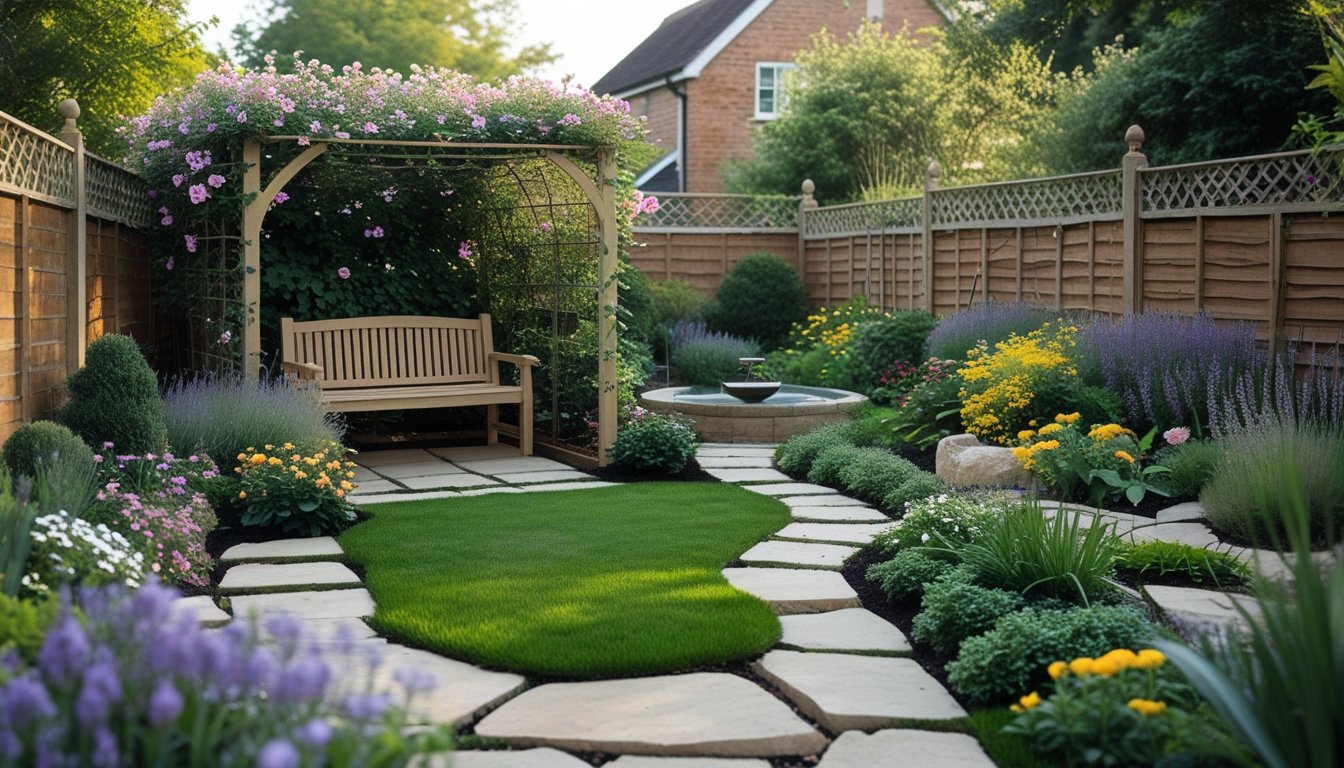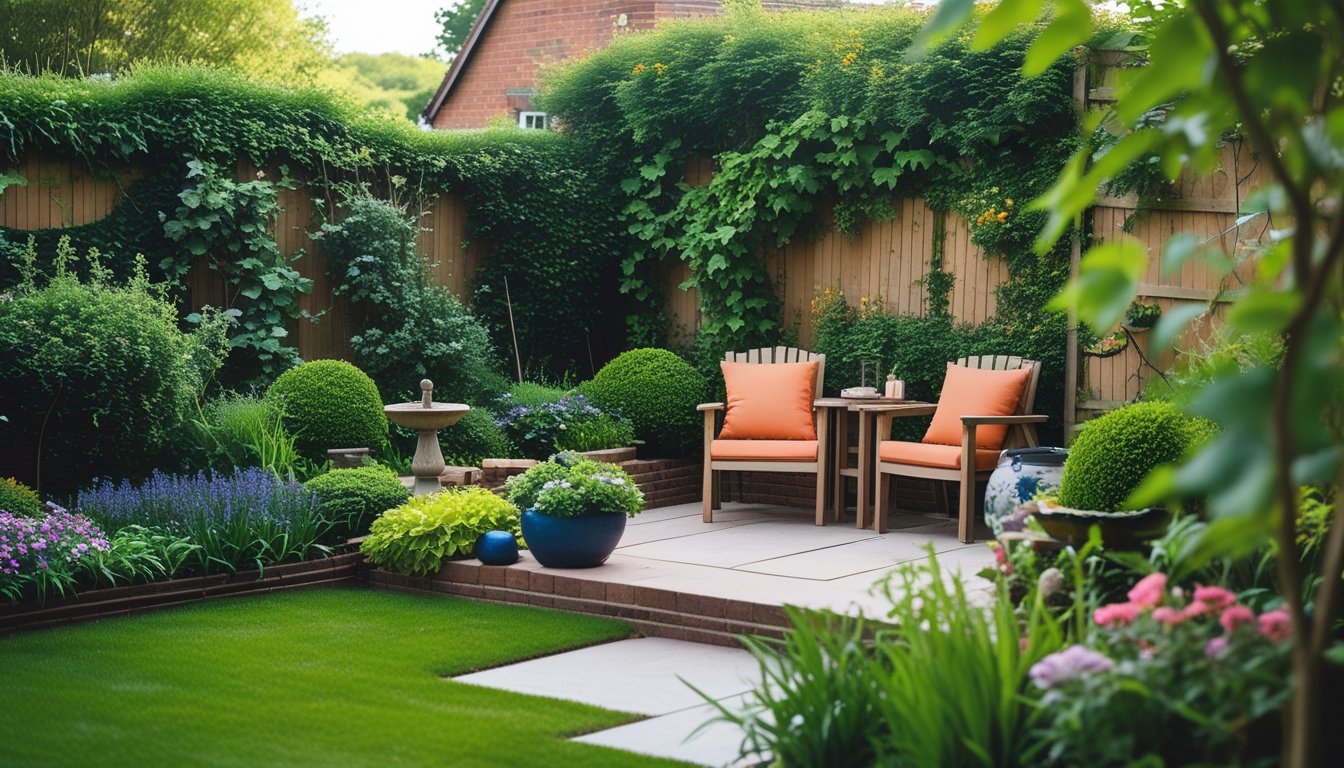Late updated: 18 May 2025 12:05
Written by: James Whitaker
Landscape Designs For Relaxation In Small British Gardens: Transformative Ideas For Tranquil Spaces
Creating a relaxing landscape in small British gardens requires thoughtful planning and clever use of space. Many of us dream of having an outdoor sanctuary, a place to unwind after a long day. By focusing on simplicity and balance, we can transform even the tiniest patch into a serene retreat. Emphasising elements such as water features, comfortable seating, and lush greenery can make a world of difference.

Our gardens may be compact, but with the right techniques, they can still offer a sense of spaciousness and tranquillity. By integrating vertical planting, we can save space and add depth. The design should cater not only to aesthetics but also to personal relaxation needs, accommodating quiet corners or alfresco dining spots tailored to our lifestyle.
Incorporating native plants and considering the natural light can enhance the garden's appeal, making it both beautiful and sustainable. It’s important that we carefully select each element to ensure it harmonises with the overall design. These strategies not only maximise the space but also promote a calm, inviting atmosphere that truly embodies relaxation.
Key Takeaways
- Simplicity and balance are key for creating relaxing small garden spaces.
- Vertical planting helps save space and adds depth to compact gardens.
- Native plants and natural light enhance beauty and sustainability.
Key Principles Of Relaxing Landscape Designs For Small British Gardens
Crafting a serene garden in a limited space involves using thoughtful design elements. By harmonising the garden with its surroundings, choosing calming colours and plants, and optimising the layout, we can maximise relaxation.
Harmonising Garden Design With British Settings
Incorporating local materials like stone and wood is crucial in reflecting the essence of British gardens. We often see formal borders paired with less structured planting, maintaining the classic English garden feel. Incorporating native plants can provide a natural aesthetic while supporting local wildlife.
Understanding our climate is also essential. By selecting plants that thrive in British weather, such as lavender and foxgloves, we ensure a robust and sustainable garden. Water features can reflect the quintessential British love for tranquil environments, enhancing the peaceful vibe. Balance in design—symmetrical paths or geometric shapes—plays a vital role in creating a cohesive space that complements British landscapes.
Selecting Soothing Colour Palettes And Plant Combinations
Choosing the right colour palettes greatly affects the garden's tranquillity. We recommend soft hues like blues, purples, and greens that bring a cooling effect, ideal for small spaces. By combining colours that blend harmoniously, the garden feels more expansive and inviting.
Plant combinations are equally important. Evergreens provide year-round interest and structure, while seasonal plants like roses and hydrangeas add bursts of colour. Mixing textures with contrasting foliage and flowers encourages a dynamic look without overcrowding the small space. Tall, soft grasses or delicate ferns can introduce movement and variety.
Maximising Space Through Thoughtful Layouts
Effective space utilisation is a prime consideration. Vertical gardening using trellises or wall planters can add depth and character. Spaciousness can be enhanced by creating defined zones using hedges or planters, making the garden feel larger and more functional.
Strategic pathways and seating areas ensure ease of movement and relaxation spots. By aligning these elements with the garden’s natural lines, we prevent any cramped appearance. Implementing mirrors in shaded areas can reflect light, enhancing the perception of space. This thoughtful arrangement transforms small gardens into serene retreats.
Essential Features And Techniques For Creating Tranquil Retreats

In small British gardens, integrating essential design techniques can transform a space into a soothing retreat. Key features include thoughtfully placed seating, calming water elements, and innovative use of vertical space.
Seating Area Planning For Comfort And Calm
When planning seating areas, the focus should be on comfort and tranquillity. Garden furniture should offer both comfort and fit well within the garden’s dimensions. Natural materials like wood or rattan provide a soothing aesthetic. Consider positioning seating to capture the best views, whether that’s the entire garden or a specific focal point.
Adding cushions in soft neutral tones can enhance comfort and blend with the surrounding greenery. Create separate zones with seating to encourage different relaxation activities like reading or meditating.
Designing With Water Features And Soft Lighting
Water features are an excellent addition for creating tranquillity. The gentle sound of water flowing from a small fountain or pond offers immediate relaxation. When space is limited, wall-mounted water features are efficient and elegant. Placing these features strategically near seating areas allows us to enjoy their calming effects.
Soft lighting emphasises the garden's features without overpowering. Using solar-powered lights in strategic spots such as around pathways or seating areas enhances the garden's ambiance in the evening. Delicate fairy lights or lanterns around water features create magical reflections, transforming the garden as night falls.
Utilising Vertical Gardening And Climbing Plants
Vertical gardening maximises space, particularly in a smaller garden setting. By using walls, fences, or specially designed vertical planters, we can introduce an array of greenery without sacrificing ground space. Climbing plants like clematis or ivy add layers of greenery and can create a sense of enclosure, helping to define different garden areas.
Incorporating climbers adds visual interest and can also provide shade or privacy, enhancing the peacefulness of the retreat. Incorporating drought-tolerant plants ensures the garden remains lush with minimal maintenance, an essential factor in overall design.
Incorporating Hardscaping And Outdoor Rugs
Hardscaping plays a key role in balancing natural elements. Using crazy paving can introduce character and texture to garden paths, while stone and gravel can delineate various zones. These elements reduce the need for maintenance and add structure.
Introducing outdoor rugs provides a layer of comfort and softness, especially in seating areas. Opt for weather-resistant options that can withstand British weather conditions. These rugs can add bursts of colour or patterns, enhancing the garden’s design while ensuring it remains a comfortable retreat from daily life.
Frequently Asked Questions

Creating a peaceful retreat in a small British garden involves carefully selecting plants, using design elements effectively, and managing space constraints.
What are the best plants to use for a tranquil small garden in the UK?
In our gardens, hardy perennials such as lavender and foxgloves offer both beauty and ease of care. Incorporating ferns and hostas can add lush greenery. For a scent that calms, rosemary and chamomile are excellent choices and thrive in the UK climate.
How can I design a low-maintenance, relaxing garden within a limited budget?
Using native plants can reduce costs, as they require less water and care. We can also choose gravel or bark mulch instead of grass to minimise upkeep. Repurposed or recycled furniture can provide charming seating options without breaking the bank.
What design elements are essential for creating a peaceful English garden in a confined space?
A small water feature like a fountain can bring soothing sounds. We find that winding paths or stepping stones add intrigue. Arranging plants in layers can create privacy and a sense of depth, ensuring a truly serene experience even in limited spaces.
How can I incorporate water features into a small British garden to promote relaxation?
Compact fountains or wall-mounted waterfalls work well. Containers or small ponds with water lilies can be equally peaceful. When placed near seating, these features bring the gentle sound of flowing water, enhancing relaxation.
In what way can colour theory be applied to a small garden to enhance serenity?
Cool colours like blues, purples, and greens have a calming effect. Incorporating white flowers can add brightness and a sense of space. We suggest choosing a cohesive palette to prevent visual clutter, making the garden feel unified and soothing.
What are some modern design strategies for achieving a sense of calm in a compact garden area?
Minimalism can be powerful; using fewer elements helps maintain calm. Vertical gardening maximises space while adding greenery. We might also choose multifunctional furniture, ensuring the garden is both practical and tranquil, serving as a retreat from daily stress.
